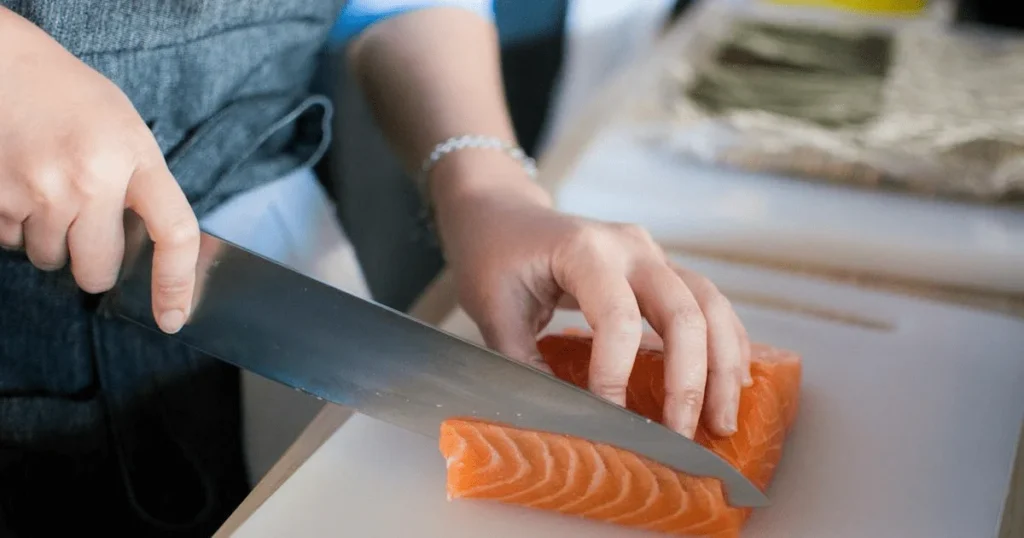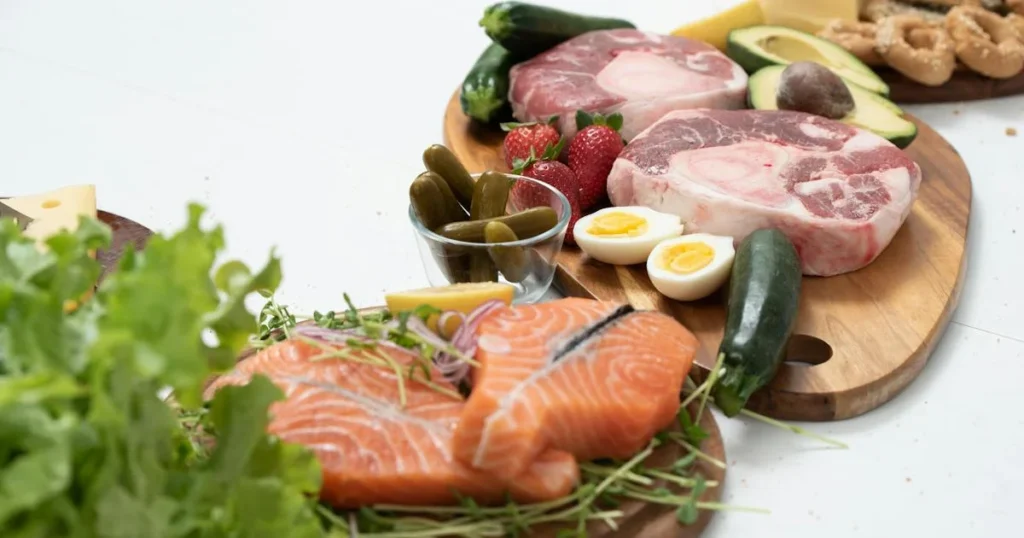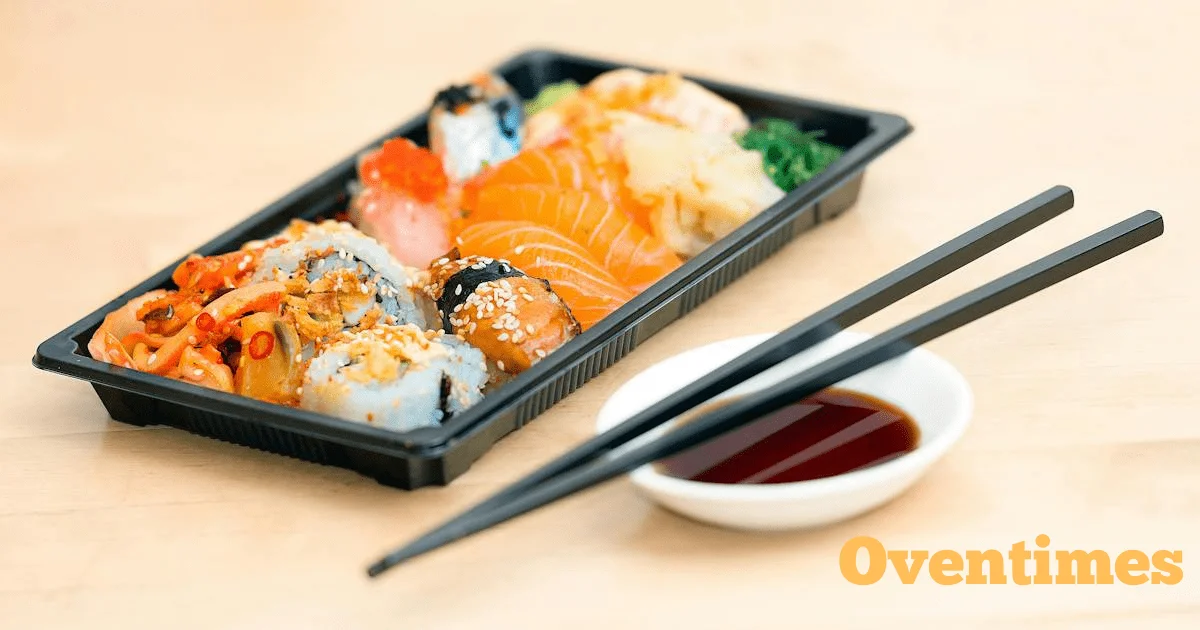It is easy to cook salmon in the oven. With minimal preparation, you can bake salmon to tender, flaky perfection in under 30 minutes.
This comprehensive guide will teach you everything you need to know about cooking salmon in the oven, from choosing the right cut to proper cooking times and temperatures. Follow these tips and techniques for mouthwatering oven-baked salmon every time.
Choosing the Right Salmon Cut

When cooking salmon in the oven, you’ll want to choose a thick, center-cut salmon fillet. Thinner tail-end pieces will dry out quickly with oven cooking. Here are the best salmon cuts for cooking whole fillets in the oven:
. Center-Cut Salmon Fillets
Center-cut fillets are slices cut from the thickest part of the salmon. They are evenly thick through the middle and taper slightly at the ends.
Center-cut fillets hold their moisture well when baked, ensuring tender and flaky results. They offer the best value and eating quality.
. Salmon Steaks
Salmon steaks are cross-section slices of salmon cut perpendicular to the backbone. They are thicker than fillets with bones in the center. Choose steaks at least 1-1.5 inches thick so they don’t overcook. Salmon steaks with bones tend to stay moist during cooking.
Preparing the Salmon
Proper preparation of the salmon before cooking is essential. Here are some tips
. Let It Set Out
Take the salmon out of the refrigerator and let it come closer to room temperature before cooking, about 15-30 minutes. This helps it cook more gently and evenly.
. Pat It Dry
Pat the salmon fillets dry with paper towels. Excess moisture on the surface can cause steaming instead of searing.
. Brush with Oil or Rub
Brush a thin layer of oil over the salmon or rub lightly with oil. Oil helps conduct heat evenly to the fish.
. Season Generously
Season the salmon liberally with salt and pepper. You can also use other spices or herb rubs. Season under the skin as well for flavorful salmon.
How to Cook Salmon Fillets in the Oven
Follow these simple steps for perfect oven-baked salmon fillets:
Preheat Oven
Preheat the oven to 400°F. This high heat will give you a nice sear on the salmon.
. Use a Rimmed Baking Sheet
Line a rimmed baking sheet with parchment paper or foil for easy cleanup. The rimmed pan will catch any juices.
. Place Fillets Skin-Side Down
Place seasoned salmon fillets skin-side down on the prepared baking sheet. The skin helps protect the tender flesh.
. Cook 8-12 Minutes
Bake for 8-12 minutes, until the salmon is opaque and flakes easily with a fork. The timing depends on thickness.
. Broil for Browning
If you want browning, broil the salmon on high for 1-2 minutes at the end. Watch closely to avoid burning.
. Let It Rest Briefly
Let the baked salmon rest for 5 minutes before serving. This allows juices to redistribute through the fish.
| Thickness | Bake Time |
|---|---|
| 1 inch | 8-10 minutes |
| 1.5 inches | 12-15 minutes |
| 2 inches | 15-18 minutes |
Bake times are for medium doneness. For rare salmon, shave off 2-3 minutes. For well-done, add 2-3 minutes.
How to Cook Salmon Steaks in the Oven

For salmon steaks with the bone in, use this oven method:
. Heat Oven to 425°F
Preheat the oven to 425°F to get a good sear on the steaks.
. Oil a Baking Dish
Coat a baking dish with oil to prevent sticking. Use a skillet if you want more browning.
. Bake 10-12 Minutes
Place salmon steaks in the dish and bake for 10-12 minutes per inch of thickness. Check often to prevent overcooking.
. Broil for Browning
For more color, broil for just 1-2 minutes at the end. But stay close to avoid burning.
. Check for Doneness
The fish should flake easily and become opaque all the way to the center when fully cooked.
Common Mistakes to Avoid
It’s easy to over or undercook salmon in the oven. Here are some common pitfalls and how to prevent them:
. Undercooking
If the salmon is undercooked, it will have a raw, translucent look and won’t flake easily. Avoid this by using a thermometer and cooking to 145°F. Also ensure fillets are 1 inch or less.
. Overcooking
Overcooked salmon dries out quickly. Prevent this by monitoring closely, not cooking at too high of heat, and removing it once it flakes easily. Take thicker fillets off sooner.
. Uneven Cooking
If salmon browns or cooks faster on the sides, your oven may have hot spots. Rotate the pan halfway through cooking to help prevent uneven cooking.
. Sticking to the Pan
Brush pans well with oil before cooking. Don’t move the salmon too soon or it could stick. Let it develop a nice crust first.
. Burning or Drying Out
Use a lower oven temp, like 375°F, if the fish is cooking too quickly on the outside but not inside. Tenting with foil can help prevent burning or drying out.
Marinades, Rubs, and Toppings for Salmon
One way to infuse delicious flavor into oven-baked salmon is to marinate, rub, or top it before cooking. Here are some tasty ideas:
. Wet Marinades
Soak salmon for 30 minutes to 2 hours in marinades like teriyaki, wine, citrus, or yogurt-herb mixes. Pat dry before cooking.
. Dry Rubs
Coat salmon with spice rubs containing brown sugar, chili powder, cumin, garlic, or jerk seasoning. Let sit for 30 minutes before baking.
. Herb and Oil
Simply drizzle salmon with olive oil and rub with fresh or dried herbs like dill, parsley, basil, thyme, or tarragon.
. Spicy Rubs
For some heat, rub salmon with mixtures containing chili powder, cayenne, paprika, garlic powder, salt, and pepper.
. Sweet and Savory
Try honey-mustard glazes, teriyaki drizzles, or fruit salsa to balance salmon’s richness. Brush on during the last 5 minutes of baking.
Cooking Times for Common Salmon Cuts
| Salmon Cut | Thickness | Oven Temp | Cook Time |
|---|---|---|---|
| Salmon fillet | 1 inch | 400°F | 8-10 minutes |
| Salmon fillet | 1.5 inches | 425°F | 12-15 minutes |
| Salmon steak | 1 inch | 375°F | 10-12 minutes |
| Salmon steak | 1.5 inches | 400°F | 12-15 minutes |
| Side salmon fillet | 0.5 inch | 375°F | 7-9 minutes |
| Skinned fillet | 1 inch | 400°F | 6-8 minutes |
Checking Salmon for Doneness

It can be tricky to judge when salmon is perfectly cooked through. Here are some foolproof ways to test:
. Flake Test
Use a fork to gently flake the thickest part. When opaque and flaky, it’s done.
. Thermometer
Insert an instant-read thermometer into the thickest area. Salmon is medium-rare at 145°F and well-done at 160°F.
. Color Change
Look for the color to become opaque from the center outward. Translucent areas mean it needs more time.
. Butteriness
Poke the fish and it should feel slightly firm yet buttery smooth. If it’s gummy, it’s underdone. Overcooked salmon will be dry.
Serving and Garnish Ideas
Baked salmon is delicious hot out of the oven or served at room temperature over salad. Here are fantastic pairing ideas:
. Fresh Herbs
Garnish baked salmon with fresh dill, parsley, chives, basil, or cilantro. The bright flavors complement the fish beautifully.
. Lemon Wedges
A squeeze of lemon juice brightens the salmon’s rich flavor. Serve wedges on the side for squeezing over top.
. Dipping Sauces
Offer flavorful dipping sauces like teriyaki, honey-mustard, or creamy dill to enhance the salmon.
. Veggie Sides
Roasted, grilled, or sautéed vegetables like asparagus, broccoli, green beans, or carrots make tasty accompaniments.
. Rice Pilaf or Quinoa
For a hearty meal, serve oven-baked salmon over rice pilaf, quinoa, or other whole grains.
. Fresh Green Salad
A light green salad with vinaigrette dressing balances the salmon wonderfully. Spinach, arugula, or kale work well.
. Crusty Bread
Serve slices of crunchy baguette, rolls, or artisan bread alongside the fish.
. Potatoes
Mashed, baked, or roasted potatoes complement oven-baked salmon for a comforting, hearty dish.
. Fruit Salsa
For a fresh contrast, make a salsa with pineapple, mango, peaches, or strawberries to spoon over the salmon.
Storing and Reheating Leftover Salmon
Have leftover baked salmon? Here are the best ways to store and reheat it:
. Storage
Refrigerate leftover salmon for 3-4 days max. Wrap tightly in plastic wrap or store in an airtight container.
. Reheating
Reheat leftover salmon gently in the oven at 300°F, wrapped in foil, or on the stovetop over low heat in a skillet. Take care not to overdry the fish.
. Flaking
Flake any leftover salmon and add to salads, rice bowls, pasta, or stir-fries. The small flakes will reheat quickly.
. Repurposing
Shred and bind leftover salmon with mayonnaise or Greek yogurt for tasty salmon salad sandwiches or wraps.
Conclusion
Cooking delicious salmon in the oven is easy with a few simple tricks. Start with high-quality, center-cut fillets or steaks about 1-1.5 inches thick. Prepare the fish by patting dry, oiling, and seasoning generously.
Bake at 400-425°F on a rimmed pan until opaque and flaky, 8-15 minutes depending on thickness. Avoid over or undercooking by monitoring doneness carefully.
Salmon pairs wonderfully with fresh herbs, veggies, rice, salad, and citrus. Leftovers can be refrigerated for up to 4 days and added to other dishes. Follow this guide for foolproof oven-baked salmon worthy of any meal.
Frequently Asked Questions
Here are some frequently asked question given below:
Should salmon be skinned before baking?
Leaving the skin on helps the tender salmon flesh hold together and protects it from overcooking. However, skin shrinks when cooked. For easier eating, you can remove it after baking when the meat releases more easily.
What temperature should I bake salmon at?
Ideally bake salmon fillets at 400-425°F to ensure proper browning and cooking through. Thicker steaks may take lower temps like 375°F. Monitor thickness and adjust temps accordingly.
How do I prevent overcooking?
Brush a thin layer of oil so salmon doesn’t dry out. Check early and often for doneness. Cook at lower temps for thicker cuts. Tent loosely with foil if browning too quickly.
Can I re-freeze previously frozen salmon?
It’s not recommended to refreeze salmon more than once, as this greatly affects texture and moisture content. Refrigerate thawed salmon for 2-3 days max.
Should I flip the salmon halfway through baking?
Flipping is not necessary since the hot baking sheet will cook the bottom. Salmon releases easily when done, so flipping risks sticking or breaking.
